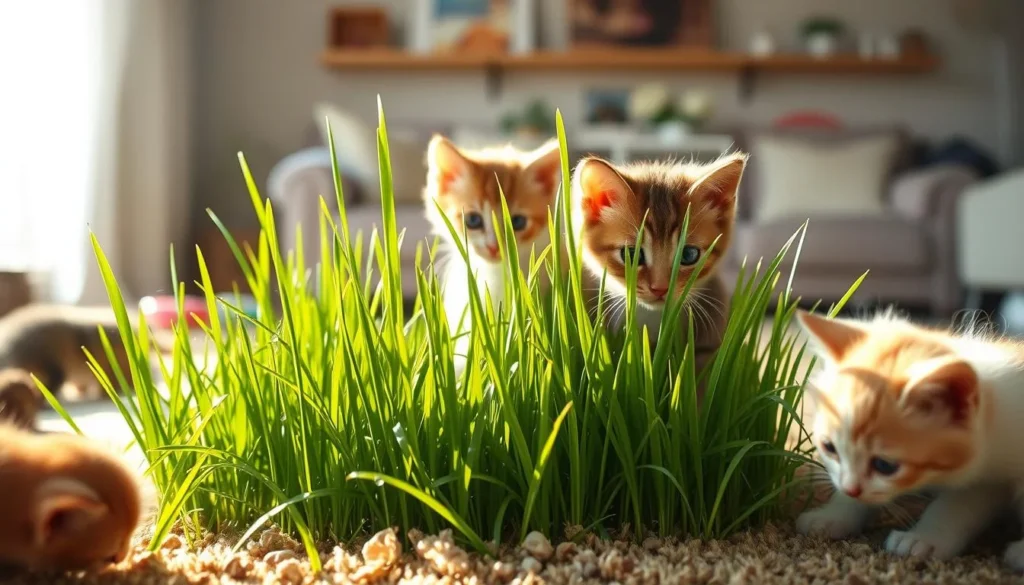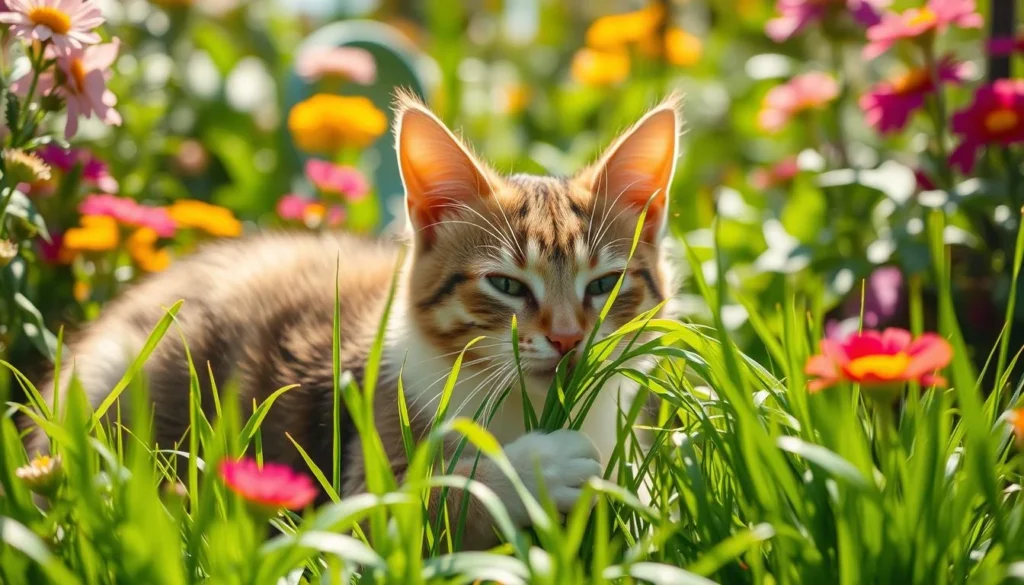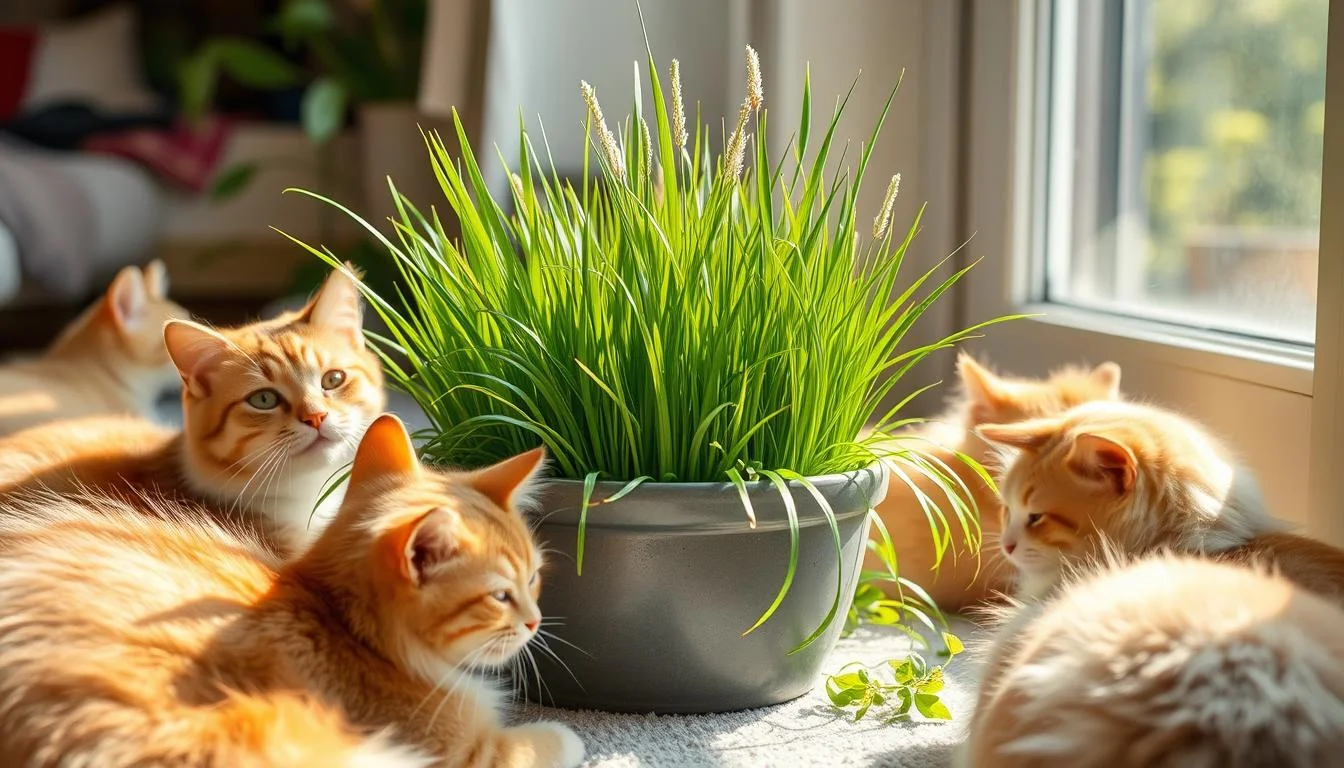Table of Contents
Every cat owner knows how our feline friends interact with their surroundings. When my rescue cat Luna started nibbling on the pet plants, I was worried. But, her craving for cat-safe greens opened a world of feline nutrition and wellness.
Cats have a natural bond with grass that’s more than just curiosity. About 70% of cats seek out grass, and cat grass is a safe, nutritious choice for indoor cats. This mix of cereal grasses, like wheatgrass, oat grass, and barley grass, brings many health benefits that can improve your cat’s life.
Learning about cat grass can help you care for your cat better. It supports their digestive health and helps with stress. These pet plants offer a natural way to boost your cat’s health in amazing ways.
Key Takeaways
- Cat grass provides essential nutrients for feline health
- Natural alternative to potentially harmful houseplants
- Supports digestive system and hairball management
- Offers mental enrichment for indoor cats
- Helps reduce stress and anxiety in felines
- Contains important vitamins and minerals
- Safe and easy to grow at home
Understanding Cat Grass and Its Natural Role
Cat grass is an interesting part of cat care that many pet owners don’t know about. Cats are mostly meat-eaters but also eat plants to stay healthy. Knowing about cat grass helps you take better care of your cat.

Cats have a special bond with plants that’s more than just curiosity. About 67% of cat owners see their pets eating grass often. This grass does important jobs for their health.
Types of Safe Grasses for Cats
When you grow cat greens, you’ll find many safe grass types. These grasses give cats important nutrients:
- Wheatgrass
- Barley grass
- Oat grass
- Rye grass
How Cats Process Plant Material
Cats can’t fully digest plants, but they use grass for important reasons. The fiber in cat grass helps:
- Move hairballs through their digestive system
- Reduce constipation
- Support natural self-purging
Historical Context of Feline Grass Consumption
“Cats have been eating grass long before they were domesticated,” says Dr. Sarah Thompson, a vet nutritionist.
Adding cat grass to your cat’s diet supports their natural behavior and health. The chlorophyll, vitamins, and minerals in these grasses help keep cats well.
But remember, cat grass should not be the main part of their diet. Treats like cat grass should make up no more than 10% of what they eat.
Digestive Health Benefits and Natural Detoxification

Cat grass is key for your cat’s digestive health. It’s a natural aid that offers many benefits beyond just food.
The fiber in cat grass works as a natural laxative. It helps keep your cat’s digestive system in check. This natural foraging behavior brings many health perks:
- Helps move food through the digestive tract
- Eliminates hairballs naturally
- Prevents constipation
- Boosts overall digestive health
Interestingly, cats eat grass as an instinct from their wild ancestors. Grass has nutrients like folic acid. It helps with oxygen transport and cell growth.
“Grass consumption is a natural method for cats to cleanse their digestive system”
Grass eating might make cats vomit. But this is a natural way for them to detox. Cats can’t fully digest grass, so vomiting helps remove indigestible parts.
For indoor cats, safe cat grass meets their foraging needs. It also helps their digestive health. Make sure the grass is pesticide-free for your cat’s safety.
Essential Nutrients and Vitamins in Cat Grass
Cat grass is more than just a simple plant. It’s a powerful feline nutrition supplement. It delivers a remarkable array of essential nutrients to support your cat’s overall health. Understanding the nutritional profile of edible cat grasses can help you make informed decisions about your pet’s diet.
Let’s explore the incredible nutrient composition that makes cat grass a valuable addition to your feline’s diet:
Key Vitamins in Cat Grass
- Vitamin A: Supports eye health and immune function
- Vitamin B Complex: Enhances energy metabolism
- Vitamin C: Boosts immune system response
- Vitamin E: Promotes skin and coat health
Mineral Powerhouse
Cat grass contains an impressive mineral profile that contributes to your cat’s wellness:
- Calcium: Strengthens bones and teeth
- Iron: Supports blood health
- Magnesium: Aids muscle and nerve function
- Folic acid: Supports red blood cell production
Chlorophyll’s Health Benefits
“Chlorophyll is nature’s detoxifier, providing incredible health benefits for your feline friend.”
The chlorophyll in cat grass acts as a natural detoxification agent. It helps cleanse your cat’s system, supports digestive health, and provides a natural source of nutrients. These nutrients complement their primary diet.
By integrating edible cat grasses into your pet’s routine, you’re giving them a natural, nutrient-rich supplement. This supplement supports their overall well-being.
Hairball Prevention and Management
Dealing with hairballs is a common challenge for cat owners. Kitty greens offer a natural solution to help your feline friend manage these pesky fur clumps. Understanding how cat-safe greens can support your cat’s digestive health is key to preventing hairballs.
Longhaired breeds like Persians and Maine Coons are more prone to hairballs. As cats groom themselves, they swallow hair, which can build up in their digestive tract. Cat grass is a valuable tool in managing hairball issues.
“Plant consumption is a natural behavior for cats that can help maintain digestive health”
Here are key benefits of using kitty greens for hairball management:
- Provides natural roughage to help move hair through the digestive system
- Assists cats in naturally expelling hairballs more easily
- Supports overall digestive health
- Reduces the frequency of hairball-related discomfort
Veterinarians suggest watching your cat’s grass consumption. Occasional plant eating is normal, but frequent hairballs might mean health issues. A diet rich in fiber and proper hydration can help manage hairballs.
Start introducing cat-safe greens slowly and see how your cat reacts. Regular grooming and a balanced diet can help reduce hairball problems.
Cat Grass as a Natural Stress Reliever
Indoor cats often face stress and boredom. This makes natural enrichment key for their mental health. Cat grass is a powerful solution, providing benefits beyond just food.
Stress reduction is vital for indoor cat care. Studies show that natural cat foraging can cut stress by up to 50%. Cat grass offers an interactive experience that mimics wild foraging.
Impact on Feline Behavior
Cats have a natural urge to explore and interact. Indoor cat gardening with cat grass meets these instincts by:
- Providing mental stimulation
- Reducing destructive behaviors
- Creating a safe outlet for exploration
Stress Reduction Mechanisms
Chewing and interacting with cat grass triggers positive responses:
- Releases endorphins that promote relaxation
- Mimics natural grazing behaviors
- Offers a sensory-rich experience
Benefits for Indoor Cats
For cats stuck indoors, cat grass is vital for their mental health. About 60% of cat owners use cat grass to fight stress and boredom.
“Cat grass transforms a static indoor environment into a dynamic, engaging space for felines.”
Adding cat grass to your home makes it more stimulating. It supports your cat’s mental and physical health, making indoor living better and more enriching.
Supporting Your Cat’s Dental Health
Keeping your cat’s teeth clean can be tough. But, cat-safe greens are a natural way to help. When your cat chews on these greens, it’s more than just fun. It helps clean their teeth and cuts down on plaque.
Studies show that cat grass has big dental benefits:
- Reduces plaque by up to 30%
- Helps scrape away tartar naturally
- Freshens breath through chlorophyll content
The fiber in cat-safe greens is key for dental care. Chewing on these greens is like a gentle brushing for your cat. It removes food bits and bacteria from their teeth.
“Cat grass can be a simple yet effective supplement to your cat’s dental care routine”
Even though kitty greens are good, they’re not a full dental care plan. Vets say to use cat grass as a part of oral care, not the whole thing.
Adding cat-safe greens to your pet’s diet helps their teeth naturally. It also makes their life more interesting.
Natural Alternative to Harmful House Plants
Creating a pet-safe home means choosing the right indoor plants. Cat grass is a great choice for pet owners looking for safe plants. It helps keep your cat away from harmful plants.
It’s important to know which plants are bad for cats. Some common plants can be very dangerous if cats eat them.
Common Toxic Plants to Avoid
- Lilies (extremely toxic to cats)
- Pothos
- Philodendron
- Dieffenbachia
- Sago Palm
Safe Plant Alternatives
There are many safe plants that are beautiful and won’t harm your cat. Here are some good options:
- Spider Plant (Chlorophytum comosum)
- Zebra Plant (Haworthia fasciata)
- African Violet
- Parlor Palm
- Air Plants
Creating a Cat-Safe Environment
Using safe plants can help keep your cat away from bad ones. Put cat grass near other plants to keep your cat interested in safe ones. The ASPCA says to watch your pet around plants and have a variety of safe ones.
“Prevention is always better than cure when it comes to protecting your feline companions from toxic plants.”
By picking the right plants and adding cat-safe greens, you can make a safe and fun space for your cat indoors.
Weight Management and Natural Foraging
Keeping your cat at a healthy weight can be tough. But, natural cat foraging offers a smart solution. Edible cat grasses are low in calories. They meet your cat’s natural urge to graze while helping them stay at a good weight.
Cats are born to hunt and forage. By adding cat grass to their diet, you give them a healthy outlet. It lets them act like their wild ancestors, without extra calories.
“Cat grass is more than just a plant – it’s a pathway to your cat’s natural wellness.”
- Reduces tendency to overeat unhealthy treats
- Provides mental stimulation
- Supports natural grazing behaviors
- Helps manage weight without restrictive dieting
Begin with small amounts of edible cat grass. These plants are full of nutrients. They can stop your cat from eating too many treats and help them eat better.
Always talk to your vet about a weight management plan. Include natural cat foraging in it.
Boosting Immune System Function
Your cat’s immune system is a complex network that needs the right food to work well. Cat grass is a powerful supplement that boosts your cat’s immune system. It has natural nutrients that help your pet’s health from the inside.
Cat grass is packed with nutrients that help your cat’s immune system. The main benefits are:
- High levels of antioxidants that fight free radicals
- Essential vitamins that boost immune defense
- Natural detoxification properties
- Support for digestive system health
“A healthy gut is the foundation of a robust immune system” – Veterinary Nutrition Experts
Feline nutrition supplements like cat grass are key for your cat’s health. Cat grass has chlorophyll and antioxidants that protect cells. This helps your cat’s immune system stay strong.
Adding cat grass to your cat’s diet is a natural way to support their immune system. This nutrient-rich grass is a simple yet effective way to boost your cat’s health and energy.
Growing Your Own Cat Grass at Home
Indoor cat gardening is a fun way for pet owners to enrich their cat’s life. It’s easy to grow cat greens at home. This can greatly benefit your cat’s health and happiness.
To start your cat grass garden, you need some basic knowledge and simple steps. It’s easy to do, even if you’re new to gardening.
Essential Growing Tips
- Choose high-quality seeds like wheat, oats, barley, or rye
- Select a 10-inch pot with drainage holes
- Use organic potting soil for best results
- Maintain soil temperature between 72-78 degrees Fahrenheit
Maintenance Requirements
For successful indoor cat gardening, you need to care for your plants regularly. Here are some important tips:
- Water seeds lightly to keep soil moist but not waterlogged
- Cover seeds loosely with plastic wrap for 1-2 days during initial germination
- Check moisture levels daily during the first week
- Trim grass periodically to encourage fresh growth
Best Growing Conditions
Cat grass needs specific conditions to grow well. Start by placing the planter in a warm, semi-dark area. Once the sprouts appear, move it to a sunny spot. Your cat grass should grow 4-5 inches in 4-7 days.
“A fresh supply of cat grass can transform your indoor pet’s environment and health.” – Feline Nutrition Experts
To keep your cat happy, sow new seeds every 1-2 weeks. Replace older, yellowing grass. This way, your cat always has fresh, healthy greens to enjoy.
Safe Consumption Guidelines and Monitoring
Adding cat-safe greens to your cat’s diet needs careful thought. Edible cat grasses can be very good for them. But, it’s important to watch them closely to keep them safe and healthy.
- Limit initial consumption to 5 minutes, 1-2 times per week
- Observe your cat’s reaction and eating patterns
- Check for any signs of digestive discomfort
- Ensure the grass is fresh and free from mold
“Careful monitoring helps prevent possible health issues while letting your cat enjoy natural grazing.”
Look out for warning signs when your cat eats grass, such as:
- Excessive vomiting
- Persistent digestive issues
- Changes in eating habits
- Yellowing or wilting grass
Studies show that 27-37% of cats might vomit after eating grass. But, it’s not always a problem. The main thing is to know how your cat reacts to these safe greens.
Keep your cat grass in a special place, away from other plants. Change the grass every one to two weeks. This keeps it fresh and avoids health risks from older, bad plant material.
Conclusion
Exploring cat grass shows it’s a powerful natural supplement for your cat’s health. It’s more than a treat; it’s packed with nutrients and helps with digestion. It also keeps your cat’s mind sharp and body healthy.
Adding cat grass to your cat’s diet can lead to big improvements. Studies show it helps with weight, activity, and coat health. Wheatgrass, oat grass, or barley grass can all boost your cat’s health.
Not every cat will love cat grass, but the benefits are worth trying. Start slow and watch how your cat reacts. Talking to your vet can help make sure cat grass works best for your cat.
Choosing cat grass is a big step for your cat’s health. It’s a natural way to keep them healthy and happy. It meets their needs and connects with their natural instincts.
